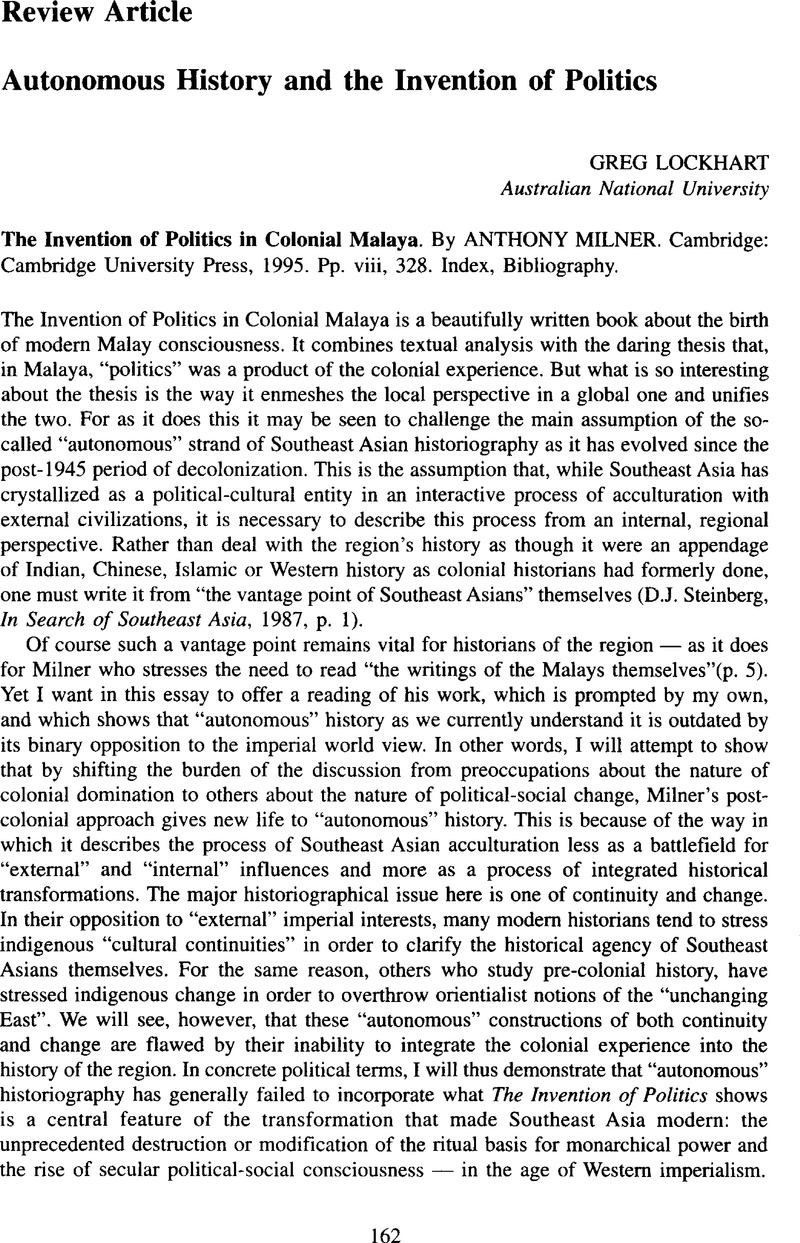No CrossRef data available.
Article contents
Autonomous History and the Invention of Politics
Published online by Cambridge University Press: 11 August 2011
Abstract

- Type
- Review Article
- Information
- Copyright
- Copyright © The National University of Singapore 1998
References
1 The works Wolters refers to in History, Culture, and Region and Anderson's, essay “Time of Darkness and a Time of Light” in Language and Power (Ithaca: Cornell University Press, 1990) (179Google Scholar) and Anthony Day's 1981 Ph.D. thesis, “Meaning of Change in Javanese Poetry”. The textual criticism of Wolters applies mainly to Tran Dynasty Vietnamese poetry. Given the “literary” nature of the texts which these scholars analyze, it is worth noting that Milner's approach is somewhat different. In fact, he analyzes the kind of “non-literary” texts — newspapers and court chronicles — that historians normally mine for information. His “unconventional” application of literary-style textual analysis to “conventional” historical sources then provokes an interesting question. Since textual analysis is about how texts constitute their meaning, is there any reason why an historian could not write a history on the basis of literary sources? In other words, is there any reason why an historian could not write a history based purely on poetry and/or novels?
2 The effect of this approach may be indicated as follows. Whatever the significance of their global connections, Steinberg thinks that a Singapore Chinese merchant with contacts in Canton or a French naval administrator in Cochinchina with allegiance to Paris “must first be seen as participants in the history of Southeast Asia” (p. 2). With respect to peasant uprisings, it is not so much the admitted imposition of modern colonial government that deserves much attention, it is the fact that the history of the Southeast Asian peasantry “contains currents that flow straight into modern times” (p. 247). When we come to an event “that affected the region as profoundly or as rapidly as World War II”, Steinberg's local vantage point could reveal that it was not so much the Japanese occupation that changed Southeast Asia, it was the effect “that wartime developments had on the thoughts and feelings of Southeast Asians” (p. 349). There is of course no particular reason to deny such “cultural continuities”. However, Steinberg's construction is severely restricted in post-colonial times.
3 See Craig Reynolds, “A New Look at Old Southeast Asia”, The Journal of Asian Studies (May 1995): 431-32. In relation to the present discussion it is worth recalling certain contradictions in the writings of Van Leur. As described by Reynolds, Van Leur prefigured “autonomous” historiography by maintaining the “weak influence” of foreign cultural influences on Indonesia. Yet Van Leur's writing, which influenced Smail's, still contained metaphors — of ships — that “entrenched the exteriority of the Western observer and thus worked against the Southeast Asian autonomy he sought to establish” (p. 432). Catching the complexity of Van Leur's position Reynolds further explains that Van Leur's use of certain contradictory metaphors was “brilliantly” engineered to “reverse” the colonial historiography, or permit Southeast Asian agency to “write back” against the modern European empires — as well as all other external influences, including Indie and Sinic. I would add that this analysis gives us a good idea of how the binary opposition between “autonomous” and colonial history was initially set up.
4 The editorial essay in the first issue of Rethinking History is by Alun Munslow. I would have been unaware of this excellent essay if David Marr had not helpfully sent me a copy.




